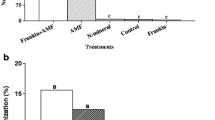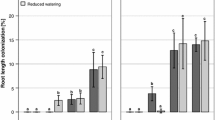Abstract
Some Acacia mangium Willd. plantations in Asia grow poorly due to low soil fertility and the absence of compatible mycorrhizal fungi. This legume tree can be colonized by arbuscular mycorrhizal (AM) and ectomycorrhizal (ECM) fungi but inoculation is not routinely practiced. This study aimed to compare the effectiveness of AM fungi and four isolates of the ECM fungus Pisolithus tinctorius (Pers.) Coker and Couch (Pt) in promoting growth of A. mangium seedlings under glasshouse conditions. AM inoculants were: Glomus etunicatum, G. fasciculatum, G. macrocarpum and Gigaspora margarita and mixed species extracted from rhizosphere soil of a Populus stand in Suwon (AMKFRI), and Carex (AMM6) and Populus (AMM7) growing in mine tailings in Korea. Pisolithus isolates were from Philippines (PtPhil) and Korea (PtKFRI, PtMKACC, PtKACC). Generally, ECM fungi promoted height and diameter growth of A. mangium more than the AM inoculants. The Korean Pisolithus increased plant dry weight by 122–145%, mixed AM inoculants by 61–97%, and Glomus and Gigaspora by 45–72% over the control. PtKACC gave the highest root colonization and promoted the highest growth and concentration of most nutrients. Mycorrhizal root colonization was positively correlated with plant dry weight, Na, Fe and Cu concentrations and N, P, K, Ca, Na, Fe and Cu contents. In conclusion, the results provide strong evidence for benefits of mycorrhizal inoculation on A. mangium seedlings under glasshouse conditions. The Korean Pisolithus isolates (particularly PtKACC), and two AM fungi (AMKFRI and AMM6) are potential mycorrhizal inoculants but their effectiveness and persistence should be determined on degraded lands in tropical countries where A. mangium is being planted for rehabilitation.


Similar content being viewed by others
References
Aggangan NS, De la Cruz RE (1991) Growth improvement of two forest tree legumes by VA mycorrhizal inoculants. Phil J Biotech 2(1):72–80
Aggangan NS, Lorilla EB, De la Cruz RE (1987) Screening for the effectiveness of four VA mycorrhizal fungi in infertile soil. Sylvatrop. Phil For Res J 12:133–139
Aggangan NS, Dell B, Malajczuk N (1996) Effects of soil pH on the ectomycorrhizal response of Eucalyptus urophylla S.T. Blake seedlings. New Phytol 134:539–546
Aggangan NS, Dell B, Malajczuk N (1997) Effects of chromium and nickel on growth of the ectomycorrhizal fungus Pisolithus and formation of ectomycorrhizas on Eucalyptus urophylla S.T. Blake. Geoderma 84:15–27
Aggangan NS, Dell B, Malajczuk N, De la Cruz RE (1999) Comparative effects of ectomycorrhizal inoculation and fertilization on Eucalyptus urophylla S.T. Blake five years after outplanting in a marginal soil in the Philippines. In: Proceedings of the 7th international workshop on BIO-REFOR, Manila, Philippines, November 1998. University of Tokyo, Japan, pp 78–82
Bonner J, Galston AW (1952) Principles of plant physiology. WH Freeman, California 499 p
Brundrett MC, Bougher N, Dell B, Grove T, Malajczuk N (1996) Working with mycorrhizas in forestry and agriculture. ACIAR monograph 32. ACIAR, Canberra
Chen YL, Brundrett MC, Dell B (2000) Effects of ectomycorrhizas and vesicular-arbuscular mycorrhizas, alone and in competition, on root colonization and growth of Eucalyptus globulus and E. urophylla. New Phytol 146:545–556
De la Cruz RE, Manalo MQ, Aggangan NS, Tambalo JD (1988) Growth of three legume trees inoculated with VA mycorrhizal fungi and Rhizobium. Plant Soil 108:111–115
De la Cruz RE, Lorilla EB, Aggangan NS (1989) Growth of Acacia auriculiformis and Acacia mangium in a marginal grassland in response to inoculation with VA mycorrhiza and Rhizobium. Presented during the conference on nitrogen fixing trees. Federal Republic of Germany, Marburg, October 8–12
Dell B, Malajczuk N, Dunstan WA (2002) Persistence of some Australian Pisolithus species introduced into eucalypt plantations in China. For Ecol Manag 169:271–281
Diouf D, Duponnois R, Bâ AT, Neyra M, Lesueur D (2005) Symbiosis of Acacia auriculiformis and Acacia mangium with mycorrhizal fungi and Bradyrhizobium spp. improves salt tolerance in greenhouse conditions. Funct Plant Biol 32(12):1143–1152
Duncan DB (1955) Multiple range and multiple F tests. Biometrics 11:1–24
Duponnois R, Bâ AM (1999) Growth stimulation of Acacia mangium Willd. by Pisolithus sp. in some Senegalese soils. For Ecol Manag 119(1–3):209–215
Duponnois R, Lesueur D (2004) Sporocarps of Pisolithus albus as an ecological niche for fluorescent pseudomonads involved in Acacia mangium Willd.–Pisolithus albus ectomycorrhizal symbiosis. Can J Microbiol 50(9):691–696
Duponnois R, Plenchette C (2003) A mycorrhiza helper bacterium enhances ectomycorrhizal and endomycorrhizal symbiosis of Australian Acacia species. Mycorrhiza 13:85–91
Duponnois R, Founoune H, Bâ AM, Plenchette C, El Jaafari S, Neyra M, Ducousso M (2000) Ectomycorrhization of Acacia holosericea A. Cunn. Ex G. Don by Pisolithus spp. in Senegal: effect on plant growth and on the root-knot nematode Meloidogyne javanica. Ann For Sci 57:305–392
Duponnois R, Plenchette C, Prin Y, Ducousso M, Kisa M, Bâ AM, Galiana A (2007) Use of mycorrhizal inoculation to improve reafforestation process with Australian Acacia in Sahelian ecozones. Ecol Eng 29:105–112
Egerton-Warburton L, Griffin BJ (1995) Differential responses of Pisolithus isolates to aluminum in vitro. Can J Bot 73:1229–1233
Galiana A, Gnahooua GM, Chaumont J, Lesueur D, Prin Y, Mallet B (1998) Improvement of nitrogen fixation in Acacia mangium through inoculation with Rhizobium. Agrofor Syst 40:297–307
Ghosh S, Verma NK (2006) Growth and mycorrhizal dependency of Acacia mangium Willd. inoculated with three vesicular arbuscular mycorrhizal fungi in lateritic soil. New Forest 31(1):75–81
Giovannetti M, Mosse B (1980) An evaluation of techniques for measuring vesicular-arbuscular infection in roots. New Phytol 84:489–500
Gomez KA, Gomez AA (1984) Statistical procedures for agricultural research, 2nd edn. John Wiley and Sons, New York, 680 pp
Gupta R, Krishnamurthy KV (1996) Response of mycorrhizal and control Arachis hypogea to NaCl and acid stress. Mycorrhiza 6:145–147
Habte M (2000) Mycorrhizal fungi and plant nutrition. In: Silva JA, Uchida R (eds) Plant nutrient management in Hawaii’s soils, approaches for tropical and subtropical agriculture. College of Tropical Agriculture and Human Resources, University of Manoa, Hawaii, p 127
Harley JL, Smith SE (1983) Mycorrhizal symbiosis. Academic Press, London
Jayakumar P, Tan TK (2005) Growth performance and nodulation response of Acacia mangium co-inoculated with Bradyrhizobium sp. and Pisolithus tinctorius. Symbiosis 40:109–141
Lee KJ, Kim YS (1986) Host range and host specificity of putative ectomycorrhizal fungi collected under ten different artificial forest types in Korea. Agric Res Seoul Natl Univ 11(2):41–47
Lee KJ, Kim JJ (1994) Effects of Pisolithus tinctorius ectomycorrhizal inoculation on in vitro rooting of tissue-cultured Quercus acutissima Carr. and of cuttings of Pinus densiflora Sieb. Et Zucc. J Kor For Soc 83(4):531–539
Marschner H, Dell B (1994) Nutrient uptake in mycorrhizal symbiosis. Plant Soil 159:89–102
Martin F, Diez J, Dell B, Delaruelle C (2002) Phylogeography of the ectomycorrhizal Pisolithus species as inferred from nuclear ribosomal DNA ITS sequences. New Phytol 153:345–357
Martin-Laurent F, Lee SK, Tham FY, Jie H, Diem HG (1999) Aeroponic production of Acacia mangium saplings inoculated with AM fungi for reforestation in the tropics. For Ecol Manag 122(3):199–207
Marx DH (1977) Tree host range and world distribution of the ectomycorrhizal fungus Pisolithus tinctorius. Can J Microbiol 23:217–223
Michigan State University (1989) User’s guide to MSTAT-C. Michigan State University, East Lansing
Murphy J, Riley JP (1962) A modified single solutions method for the determination of phosphate in natural waters. Anal Chimica Acta 27:31–36
Ruiz-Lozano JM, Azcon R (1995) Hyphal contribution to water uptake in mycorrhizal plants as affected by the fungal species and water status. Physiol Plant 95:472–478
Satter MA, Hanafi AM, Mahmud TMM, Azizah H (2007) Performance of arbuscular mycorrhiza inoculated Acacia mangium seedlings on degraded land with different rates of phosphorus. Bangl J Microbiol 24(1):9–13
Tisdale SL, Nelson WL, Baton JD (1995) Soil fertility and fertilizers. Macmillan, USA
Tripathi S, Kamal S, Sheramati I, Oelmuller R, Varma A (2008) Mycorrhizal fungi and other root endophytes as biocontrol agents against root pathogens. In: Varma A (ed) Mycorrhiza. Springer, Berlin, pp 281–306
Weber J, Ducousso M, Tham FY, Nourissier-Mountou S, Galiana A, Prin Y, Lee SK (2005) Co-inoculation of Acacia mangium with Glomus intraradices and Bradyrhizobium sp. in aeroponic culture. Biol Fertil Soil 41:233–239
Yeung EC (1999) The use of histology in the study of plant tissue cultures systems-some practical comments. In Vitro Cell Dev Biol Plant 35:137–143
Acknowledgments
This study was conducted while the senior author was on Post Doctoral Fellowship at the Korea Forest Research Institute, Suwon, Korea. The authors acknowledge Dr. Kang-Hyeon Ka (KFRI, Seoul), Rural Development Administration (Korea Agricultural Culture Collection and Mushroom Korea Agricultural Culture Collection) for the ECM cultures.
Author information
Authors and Affiliations
Corresponding author
Rights and permissions
About this article
Cite this article
Aggangan, N.S., Moon, H.K. & Han, S.H. Growth response of Acacia mangium Willd. seedlings to arbuscular mycorrhizal fungi and four isolates of the ectomycorrhizal fungus Pisolithus tinctorius (Pers.) Coker and Couch. New Forests 39, 215–230 (2010). https://doi.org/10.1007/s11056-009-9165-4
Received:
Accepted:
Published:
Issue Date:
DOI: https://doi.org/10.1007/s11056-009-9165-4




